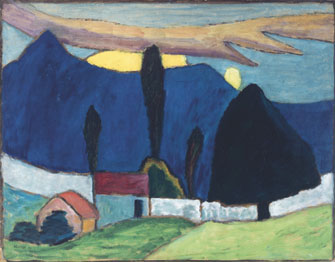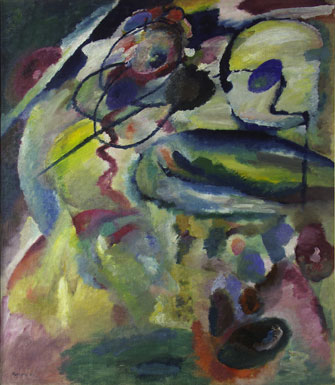Two Expessions of
German Expressionism

“Landscape with White Wall” (1910) by Gabriele Münter. © Adagp, Paris 2011
The exhibition “Expressionismus & Expressionismi: Berlin-Munich 1905-1920, Der Blaue Reiter vs Brücke” at the Pinacothèque de Paris, like many of the shows held there, is both good and bad.
The theme is an interesting one: comparing the works of two schools of German Expressionism at the beginning of the 20th century: Der Blaue Reiter (“The Blue Rider”) and Die Brücke (“The Bridge”), which shared a love for intense color but, according to the curator, had distinctively different theoretical underpinnings: the former based on purely intellectual underpinnings (which are not clearly explained) and the latter more interested in spontaneity, intuition and “direct creation” based on emotional response to what the artist saw.
Just so visitors won’t be left wondering, paintings by adherents of the two schools are conveniently identified by colored labels: blue, of course, for Der Blaue Reiter and orange for Die Brücke.
Without even looking at the labels, however, it is fairly easy to tell which is which here: the Blaue Reiter paintings have a hard-edged look, while the Brücke works are somewhat softer.
The exhibition also shows how some of Blaue Reiter painters, notably Vassily Kandinsky, evolved toward abstraction, and even presents what is supposedly the first-ever abstract

“Picture with a Circle” (1911) by Vassily Kandinsky. Photo: Archives Nakov, Paris. © Adagp, Paris 2011
work, painted by Kandinsky in 1911, “Picture with a Circle.”
The text doesn’t really explain, however, the oppositions it contends existed between the two movements, nor does it make it clear that Die Brücke, founded in 1905, predated Der Blaue Reiter, which lasted only from 1911 until the outbreak of war (which killed some of its proponents and forced several others to return to Russia) in 1914. The latter might be seen as simply an outgrowth of the former rather than its opposite.
Most of the paintings in the show are from provincial European museums, which is, again, both good and bad. Good, even wonderful, because it presents works by little-known artists, several of them women, and lesser-known works by well-known artists. I saw for the first time, for example, the work of Gabriele Münter (1867-1962), a marvelous colorist, and the talented Marianne von Werefkin (1860-1938), represented by a number of fine paintings, including the unusually subdued (in terms of colors) “Woman with a Lantern” (1910), in which the crimson red of the lantern held by the tiny bent figure of the woman, dwarfed by the darkening landscape behind her, is the only touch of brilliant color. Both of these women, by the way, were Blaue Reiter painters.
On the negative side, the fact that the paintings were borrowed from smaller museums means that we are getting a far from representative view of the more famous artists, whose major works are elsewhere. If you were to form your impressions of German Expressionism from this exhibition alone, for example, you would think the prolific Emil Nolde did nothing but flower paintings, and you would never know that Franz Marc was best known for his paintings of very blue horses.
I recommend seeing this show not so much for the distinction it makes between the two movements, but because it contains many beautiful and/or fascinating works by the artists mentioned above as well as Max Pechstein (1881-1955), Karl Schmidt-Rottluff (1884-1976), Ernst Ludwig Kirchner (1880-1938), Erich Heckel (1883-1970) and many others, which you would otherwise have to travel to some out-of-the-way place to see. I also appreciated the biographical sheets on the artists provided for those who want to know more.
Pinacothèque de Paris: 28, place de la Madeleine, 75008 Paris. Métro: Madeleine. Tel.: 01 42 68 02 01. Open daily 10:30 a.m.-6:30 p.m. (until 9 p.m. on Wednesday and Friday). Admission: €10. Through March 11. www.pinacotheque.com
Reader Michael Barker writes: “Thank you for a perceptive review of this exhibition. I suspect that as the Pinacothèque is a private enterprise and not a museum which can exchange loans, it does not have the access to major works which official institutions can obtain. Nevertheless all power to its efforts to add to the cultural scene in Paris.”
Please support Paris Update by ordering books from Paris Update’s Amazon store at no extra cost. Click on your preferred Amazon location: U.K., France, U.S.
Reader Reaction: Click here to respond to this article (your response may be published on this page and is subject to editing).
More reviews of Paris art shows.
© 2012 Paris Update
Favorite